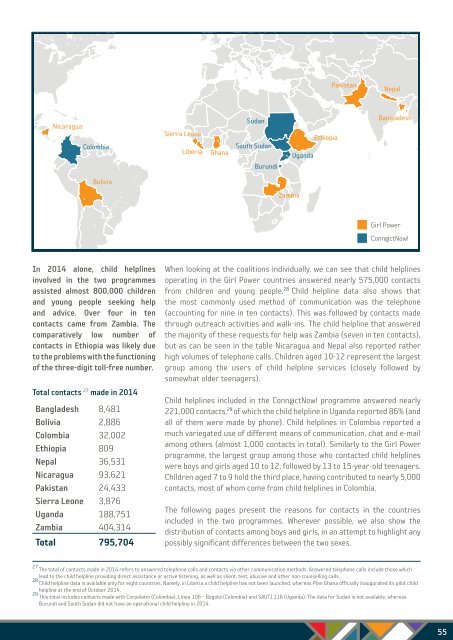The Voices of Children and Young People
FjLR300hYsM
FjLR300hYsM
You also want an ePaper? Increase the reach of your titles
YUMPU automatically turns print PDFs into web optimized ePapers that Google loves.
Pakistan<br />
Nepal<br />
Nicaragua<br />
Colombia<br />
Sierra Leone<br />
Liberia<br />
Ghana<br />
Sudan<br />
South Sudan<br />
Burundi<br />
Ug<strong>and</strong>a<br />
Ethiopia<br />
Bangladesh<br />
Bolivia<br />
Zambia<br />
Girl Power<br />
Conn@ctNow!<br />
In 2014 alone, child helplines<br />
involved in the two programmes<br />
assisted almost 800,000 children<br />
<strong>and</strong> young people seeking help<br />
<strong>and</strong> advice. Over four in ten<br />
contacts came from Zambia. <strong>The</strong><br />
comparatively low number <strong>of</strong><br />
contacts in Ethiopia was likely due<br />
to the problems with the functioning<br />
<strong>of</strong> the three-digit toll-free number.<br />
Total contacts 27 made in 2014<br />
Bangladesh<br />
Bolivia<br />
Colombia<br />
Ethiopia<br />
Nepal<br />
Nicaragua<br />
Pakistan<br />
Sierra Leone<br />
Ug<strong>and</strong>a<br />
Zambia<br />
Total<br />
8,481<br />
2,886<br />
32,002<br />
809<br />
36,531<br />
93,621<br />
24,433<br />
3,876<br />
188,751<br />
404,314<br />
795,704<br />
When looking at the coalitions individually, we can see that child helplines<br />
operating in the Girl Power countries answered nearly 575,000 contacts<br />
from children <strong>and</strong> young people. 28 Child helpline data also shows that<br />
the most commonly used method <strong>of</strong> communication was the telephone<br />
(accounting for nine in ten contacts). This was followed by contacts made<br />
through outreach activities <strong>and</strong> walk-ins. <strong>The</strong> child helpline that answered<br />
the majority <strong>of</strong> these requests for help was Zambia (seven in ten contacts),<br />
but as can be seen in the table Nicaragua <strong>and</strong> Nepal also reported rather<br />
high volumes <strong>of</strong> telephone calls. <strong>Children</strong> aged 10-12 represent the largest<br />
group among the users <strong>of</strong> child helpline services (closely followed by<br />
somewhat older teenagers).<br />
Child helplines included in the Conn@ctNow! programme answered nearly<br />
221,000 contacts, 29 <strong>of</strong> which the child helpline in Ug<strong>and</strong>a reported 86% (<strong>and</strong><br />
all <strong>of</strong> them were made by phone). Child helplines in Colombia reported a<br />
much variegated use <strong>of</strong> different means <strong>of</strong> communication, chat <strong>and</strong> e-mail<br />
among others (almost 1,000 contacts in total). Similarly to the Girl Power<br />
programme, the largest group among those who contacted child helplines<br />
were boys <strong>and</strong> girls aged 10 to 12, followed by 13 to 15-year-old teenagers.<br />
<strong>Children</strong> aged 7 to 9 hold the third place, having contributed to nearly 5,000<br />
contacts, most <strong>of</strong> whom come from child helplines in Colombia.<br />
<strong>The</strong> following pages present the reasons for contacts in the countries<br />
included in the two programmes. Wherever possible, we also show the<br />
distribution <strong>of</strong> contacts among boys <strong>and</strong> girls, in an attempt to highlight any<br />
possibly significant differences between the two sexes.<br />
27 <strong>The</strong><br />
total <strong>of</strong> contacts made in 2014 refers to answered telephone calls <strong>and</strong> contacts via other communication methods. Answered telephone calls include those which<br />
lead to the child helpline providing direct assistance or active listening, as well as silent, test, abusive <strong>and</strong> other non-counselling calls.<br />
28 Child<br />
helpline data is available only for eight countries. Namely, in Liberia a child helpline has not been launched, whereas Plan Ghana <strong>of</strong>ficially inaugurated its pilot child<br />
helpline at the end <strong>of</strong> October 2014.<br />
29 This<br />
total includes contacts made with Corpolatin (Colombia), Línea 106 – Bogotá (Colombia) <strong>and</strong> SAUTI 116 (Ug<strong>and</strong>a). <strong>The</strong> data for Sudan is not available, whereas<br />
Burundi <strong>and</strong> South Sudan did not have an operational child helpline in 2014.<br />
55


